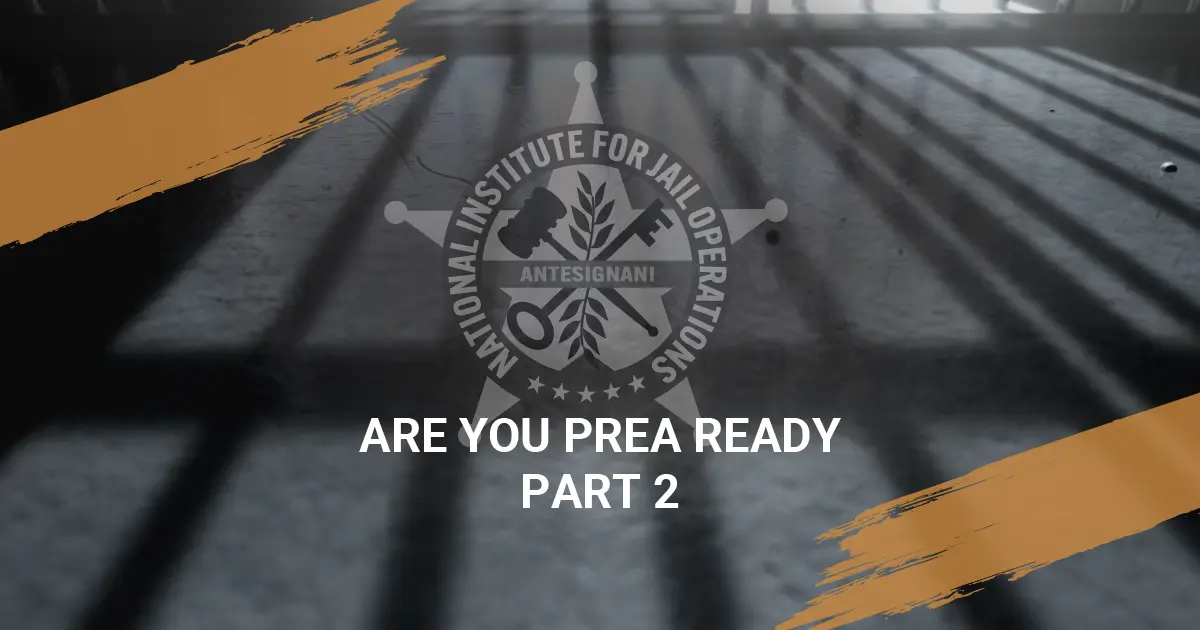by Tate McCotter and Laurie Gibbs
*NOTE* – This is part two of last month’s “Solutions to PREA”
Are you PREA ready? This doesn’t mean “are you DOJ PREA compliant!” Ask yourself can you confidently defend your policies, procedures and practices if ever required in court? Are you ready to defend claims of failure to protect and deliberate indifference based on the 8th and 14th Amendments and Prison Rape Eliminate Act passed in 2003?1 As we all know, the first thing always brought up in any jail lawsuit is a facility’s policies and procedures.
Laurie Gibbs,Director of Criminal Justice Policy Development and Compliance with Moseley Architects is well versed with the process of policy development,having worked for both State prison and local detention facilities to assist clients with their policy development for the better part of two decades. If you are one of those jails wondering where to start with your PREA policies, here are some her suggestions.
Policies and procedures provide the foundation from which all actions and processes flow within any detention facility. It is important that policies be current, pertinent, and legally and constitutionally sound in order to be useful for purposes of effectively running your facility and for defending your actions should you wind up in litigation. Although not an exhaustive list, it is important that every facility head begin the process of developing formalized policies and procedures to address various aspects of PREA. Ironically, most jails already have these processes in place, they just may need to fine tune these processes and place them into a written policy format.
- At the very least, each jail should have a policy that stipulates they uphold a zero tolerance policy toward all forms of sexual abuse and harassment. Of the jails we have worked with across the nation, only a few have a standalone policy. What we find is language that may imply they take such a stance in their inmate disciplinary policies or in their employee rules of conduct policies. In these policies, there may be prohibitions against harassment or sexual contact with inmates or there may be language which indicates an inmate will be disciplined and/or criminally prosecuted for sexual abuse, assault, or rape. However, this information is not the same as having a clearly written, separate policy that stipulates the jail’s zero tolerance stance, and the actions that will be taken to investigate, substantiate, and discipline and prosecute offenders or to prevent such incidents, e.g., documented supervisory rounds, employee and inmate training, and hiring practices. Information pertaining to how these practices will be documented should be included in any well written policy, as well as information on how incidents of sexual abuse will be reported and to whom.
- Jails should also have clearly written classification practices which are designed to assess inmates as to their propensity toward being a victim [of sexual abuse] and their propensity toward being a potential perpetrator [of sexual abuse]. Most jails have some if not all of these indicators already built into their inmate classification systems. However, many have never gone to the extent of formalizing this or communicating this in their policies or of formally indicating, in writing, that they use these indicators to guide housing placement. Naturally, any jail would want to promote an environment where these two types of offenders are separated. After all, the safety and security of inmates should be one of the primary premises of each jail’s overall mission.
- Jails should minimally be seeking to update their manuals to prohibit or limit activities which may lead to allegations of sexual abuse or harassment. Conducting documented, daily walk-throughs of the jail facility and being cognizant of blind spots and of hazards that may contribute to safety and security issues should be commonplace. Findings should be adequately documented in work orders, policies and procedures, and formally communicated in written training plans.
In addition to these suggestions, NIJO advises that definitions should be included in policy. It is interesting to note, for example, that the definitions for strip search in the DOJ PREA standards are different than those used by the Supreme Court in the Florence v. Board of Chosen Freeholders of Burlington County decision.2 A jail’s definition of general population and voyeurism do matter and may be called into question when examining a jail’s policy!
There are many other areas of jail operations that are a systemic part of PREA as a whole, such as staffing patterns, code of conduct, and enforcing inmate rules and regulations, for example. These are addressed in the NSA Legal-Based Jail Guidelines. Jail policies should also reflect specifics as they relate to how the facility addresses a zero-tolerance toward sexual abuse. Be able to articulate the rationale3 as to why you are doing what you are doing to meet the intent of PREA. This is critical! If staff can’t explain why a policy is worded a certain way or why a policy contains certain requirements now, they will never be able to do it when being cross-examined on a witness stand.
What happens if you aren’t perfect? What if you don’t have the resources, manpower or physical facility to protect inmates from sexual assault? In conducting your own self-audits and inspections, you will discover areas that perhaps need improvement, perhaps policy rewrites, need for training, more staff, a change in your classification system, or increased monitoring. Many jails have found the value of conducting regular “discovery” internal audits4 instead of simply relying on outside agencies and inspections.
Afterwards, identify and prioritize the importance of each discovery. Document the good-faith efforts you are making to address specific concerns. According to the U.S. Supreme Court, “Prison and jail officials have qualified immunity as a defense against personal liability when they act with good faith.”5 Qualified immunity is a legal principle which provides that, “[G]overnment officials performing discretionary functions generally are shielded from liability for civil damages insofar as their conduct does not violate clearly established statutory or constitutional rights of which a reasonable person would have known.” And, what should a reasonable official know? “If the law was clearly established, the immunity defense ordinarily should fail, since a reasonably competent public official should know the law governing his conduct.”6 The Supreme Court stated “It is obduracy and wantonness, not inadvertence or error in good faith” that creates the constitutional violation.”7 A jail administrator’s efforts to try to abate or fix an issue will be far more effective than simply ignoring it or doing nothing.
Smart administrators trying to run constitutional jails can articulate needs for increased staff, new security cameras and other resources and equipment to enhance the goals of protecting inmates against sexual assaults and other areas that potentially can put them liable if constitutional rights of inmates are not met. The PREA Act may be an effective means to educate commissioners and others who control the jail’s purse strings of the liability if those resources are not granted. Laurie Gibbs advises jails to view new legislation as an opportunity, rather than as something to begrudge. “New legislation can be utilized to place added emphasis on the need for funding in order to protect the interests of your facility, staff, inmates, and of public to which you serve.”
As often stated, it isn’t “if” but “when” the day occurs when your jail will need to be able to defend its policies and practices on a sexual abuse incident – no different than with any other prisoner-filed lawsuit. With the intense scrutiny and public eye out there on jails and PREA, it behooves us all to be prepared with solid policies and procedures backed with training and documentation. We stand together!
AUTHORS:
Tate McCotter, NCCE, is the Executive Director for the National Institute for Jail Operations (NIJO). He has presented and trained on legal-based jail standards, policy and procedure development, creating constitutionally safe jails, PREA, and auditing and inspection programs at numerous National Sheriffs’ Association annual and winter conferences, state sheriff association meetings, state jail administration seminars and other training venues for correctional staff and administrators.
Laurie Gibbs is Director of Criminal Justice Policy Development and Compliance with Moseley Architects. She and members of Moseley Architects staff have worked with numerous jails across the nation to assist them with policy development, training, facility planning and design, and their operational needs. Gibbs previously worked at the South Carolina Department of Corrections as both their Director of Policy Development and their Director of Legal Settlements and Compliance. In these roles, she was responsible for monitoring agency compliance with a system- wide, conditions of confinement settlement and for developing systemic policies applicable to all facilities operated by the SCDC. Gibbs has since worked in private industry and has developed policies and procedures manuals for local county jails across the nation. She can be reached at lgibbs@moseleyarchitects.com
Annotation:
- 42 USC § 15601
- 566 U.S.(2012).
- 482 U. S. 78 (1987).
- McCotter,Tate. (2013,May 6). Jail Inspections: The Results of Dressing Up for the Prom. National Institute for Jail Operations. Retrieved from: https://jailtraining.org/old/node/53
- Procunier v. Navarette,434 U.S. 555 (1978)
- Harlow v. Fitzgerald,457 U.S. 800,818,819 (1982).
- Wilson v. Seiter,111 S.Ct. 2321,2324 (1991),quoting,Whitley v. Albers,475 U.S. 312,319 (1986)



